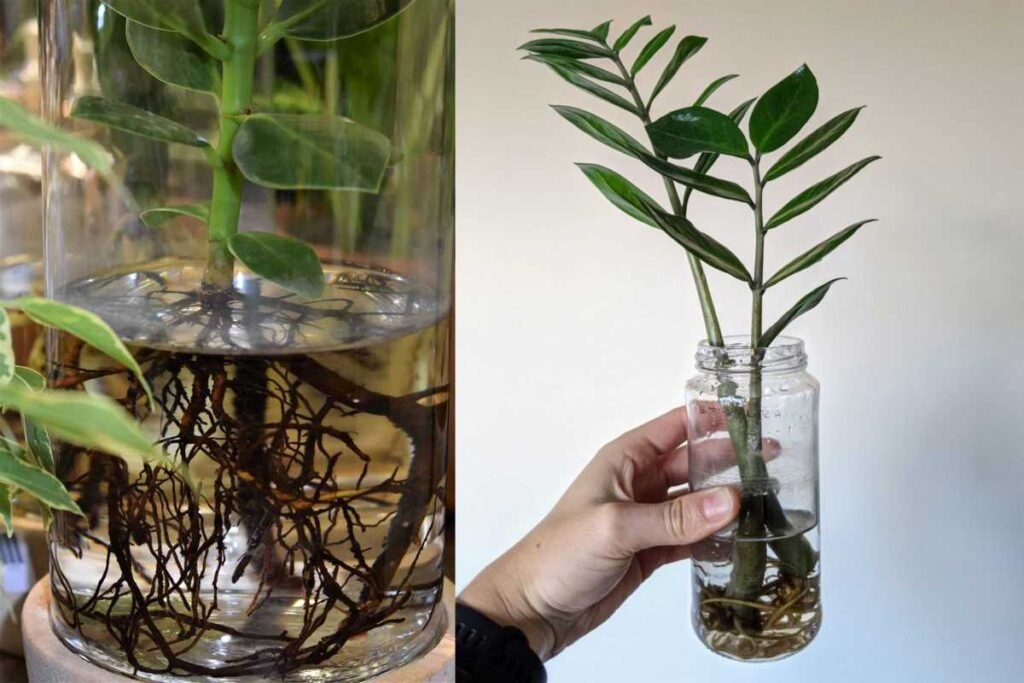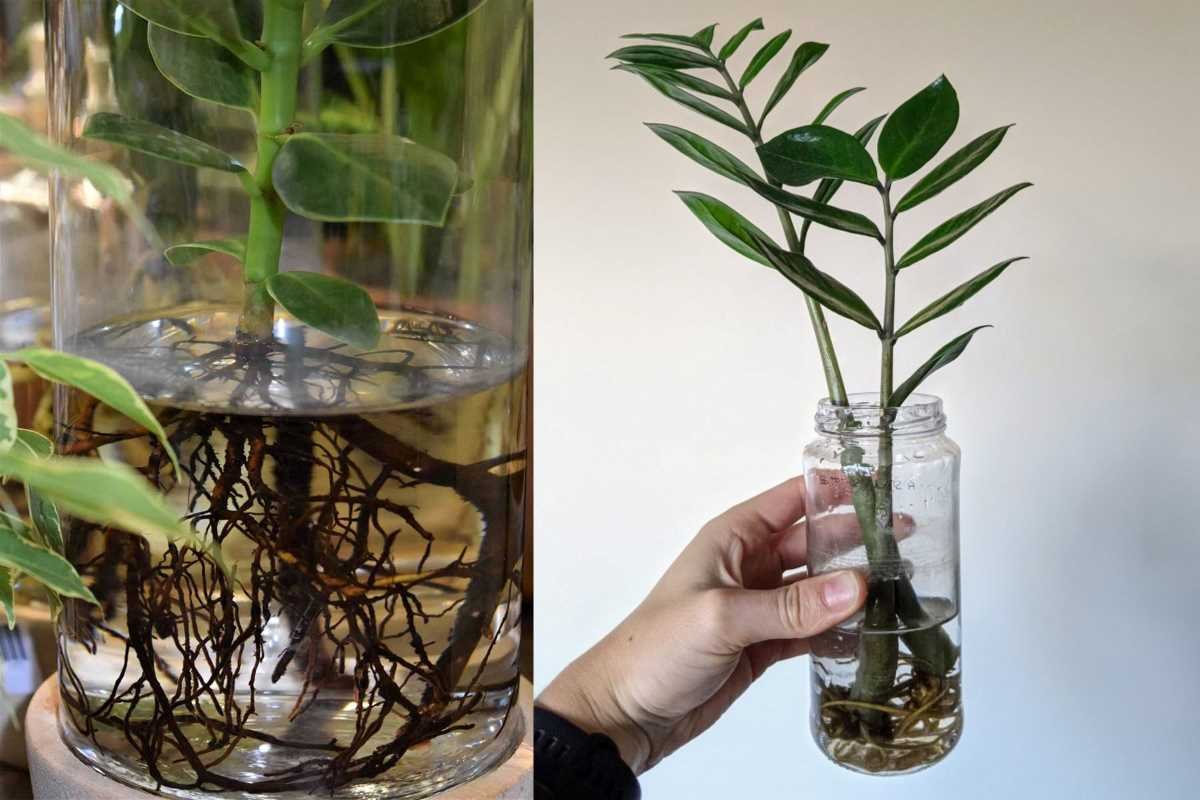The ZZ plant, scientifically known as Zamioculcas zamiifolia, has gained popularity as an indoor plant due to its attractive glossy foliage and low-maintenance requirements.
Beyond its aesthetic appeal, one of the remarkable features of the ZZ plant is its ability to propagate easily.
Among the various propagation methods, water propagation stands out as a simple and effective way to multiply your ZZ plant collection.
In this comprehensive guide, we will delve into the fascinating world of propagating ZZ plants in water, exploring the step-by-step process, essential tips, and common pitfalls to ensure successful propagation.

Benefits of Water Propagation for ZZ Plants
Water propagation offers several advantages for propagating ZZ plants. Firstly, it is a simple and accessible method that does not require any specialized knowledge or equipment.
Additionally, water propagation allows you to observe the progress of root development, giving you a clear indication of success.
This method also reduces the risk of transplant shock that can occur when moving cuttings directly into soil.
Furthermore, water propagation can be an exciting project for plant enthusiasts, as you witness the growth and development of new roots firsthand.
With these benefits in mind, let’s dive into the process of propagating ZZ plants in water.
Preparing for ZZ Plant Water Propagation
Before you begin propagating your ZZ plant in water, it’s essential to prepare adequately. Here are the key steps to ensure a smooth propagation process:
- Selecting the Right Plant:
- Choose a healthy ZZ plant with mature stems and a strong root system.
- Avoid selecting plants with signs of disease, pests, or stress.
- Gathering the Required Materials:
- Sharp, sterilized pruning shears or scissors for taking cuttings.
- A clean glass or jar for holding the cuttings and water.
- Filtered or distilled water to prevent harmful chemicals from hindering root growth.
- Optional: rooting hormone to promote faster root development (although ZZ plants generally root well without it).
By preparing these materials, you set the foundation for successful ZZ plant water propagation.
Step-by-Step Guide to Propagating ZZ Plants in Water
Now, let’s explore the step-by-step process of propagating ZZ plants in water. Following these guidelines will increase your chances of achieving healthy root growth and successful propagation:
Step 1: Preparing the Cuttings
- Choose stems that are at least 6 inches long, preferably with multiple leaflets.
- Make clean cuts just below a node, ensuring at least one or two leaf nodes are present on each cutting.
- Remove any lower leaves, leaving only the top few intact.
Step 2: Choosing the Water Vessel
- Select a glass or jar that can accommodate the cuttings and provide stability.
- Ensure the vessel is clean and free from any residue that may harm the cuttings.
Step 3: Water Propagation Setup
- Fill the vessel with filtered or distilled water, leaving enough space for the cuttings without submerging the leaves.
- If using rooting hormone, follow the manufacturer’s instructions and lightly dust the cut ends before placing them in the water.
Step 4: Providing Optimal Conditions
- Place the water vessel in a bright location, avoiding direct sunlight that may cause heat stress.
- Maintain a consistent temperature between 65°F to 75°F (18°C to 24°C).
- Avoid extreme temperature fluctuations and drafts.
Step 5: Monitoring and Maintenance
- Monitor the water level regularly, ensuring it remains at an appropriate level.
- Change the water every two to three weeks, or when it becomes cloudy or foul-smelling.
- Inspect the cuttings for any signs of rot, discoloration, or pests.
- Patience is key, as root development can take anywhere from a few weeks to a few months.
Troubleshooting Common
During the ZZ plant water propagation process, you may encounter some common issues. Let’s explore them and learn how to address them effectively:
- Yellowing or Rotting Cuttings:
- Yellowing or rotting of cuttings can indicate excessive moisture or poor water quality.
- Trim off any affected portions and change the water, ensuring cleanliness and proper water levels.
- Adjust the environment to reduce excessive humidity or stagnant air.
- Mold or Fungal Growth:
- Mold or fungal growth can occur due to high humidity or poor air circulation.
- Remove the affected cuttings, rinse the vessel with a mild bleach solution, and replace the water.
- Improve air circulation by placing the vessel near a fan or opening windows.
- Rooting Failure:
- If your cuttings fail to root, ensure you’re using healthy stems with multiple leaf nodes.
- Check the water quality and change it regularly to prevent bacterial growth.
- Consider using a rooting hormone to stimulate root growth.
Transitioning ZZ Plant Cuttings to Soil
Once your ZZ plant cuttings have developed a healthy root system in water, it’s time to transition them to soil for continued growth. Follow these steps for a successful transition:
- Choose the Right Soil and Container:
- Select a well-draining potting mix suitable for houseplants.
- Choose a container with drainage holes to prevent waterlogging.
- Prepare the Transplant:
- Gently remove the cuttings from the water, taking care not to damage the fragile roots.
- Create a hole in the soil mix and place the cutting, ensuring the roots are adequately covered.
- Lightly press the soil around the base of the cutting to secure it.
- Provide Optimal Care:
- Place the potted cuttings in a well-lit area with indirect sunlight.
- Water the newly potted cuttings, allowing the soil to dry partially between waterings.
- Maintain a consistent temperature and avoid exposing the plants to extreme conditions.
Conclusion
Propagating ZZ plants in water is an exciting and rewarding experience for plant enthusiasts.
With the simple steps outlined in this comprehensive guide, you can successfully propagate your ZZ plant collection and expand your indoor greenery.
Remember to select healthy cuttings, provide optimal conditions, and troubleshoot any issues that arise during the process.
Patience and attentiveness will pay off as you witness the growth of new roots and the transformation of cuttings into independent plants.
So, embark on your ZZ plant propagation journey with confidence, and enjoy the satisfaction of nurturing new life from your beloved ZZ plants.
Related FAQs:
Can all types of ZZ plants be propagated in water?
Yes, water propagation is generally suitable for all varieties of ZZ plants. Whether you have a traditional green ZZ plant or a variegated variety, you can follow the same steps to propagate them in water.
How long does it take for ZZ plant cuttings to develop roots in water?
Root development can vary from a few weeks to a few months, depending on various factors such as temperature, light conditions, and the health of the cuttings. It’s important to be patient and provide consistent care while waiting for root growth.
Do I need to use rooting hormone for ZZ plant water propagation?
While ZZ plants can root successfully in water without the use of rooting hormone, some plant enthusiasts prefer to use it to stimulate faster root growth. It is entirely optional, and you can achieve successful propagation without it.
Can I use tap water for ZZ plant water propagation?
It is best to use filtered or distilled water for ZZ plant water propagation. Tap water often contains chemicals like chlorine or fluoride, which can hinder root development or damage the cuttings. If you don’t have access to filtered or distilled water, you can leave tap water in an open container for 24 hours to allow the chemicals to dissipate before using it.
What should I do if my ZZ plant cuttings are rotting in water?
If you notice rotting or yellowing of the cuttings, it is an indication of excessive moisture or poor water quality. Trim off the affected portions of the cuttings, change the water, and ensure the water levels are appropriate. Adjust the environment to reduce excessive humidity or stagnant air around the cuttings.
Can I propagate ZZ plants directly in soil instead of water?
Yes, ZZ plants can also be propagated directly in soil. However, water propagation offers the advantage of better visibility of root development and reduces the risk of transplant shock. It is a preferred method for many plant enthusiasts.
How do I know when it’s time to transition ZZ plant cuttings from water to soil?
Once your ZZ plant cuttings have developed a healthy root system with multiple roots measuring at least an inch long, it’s a good indication that they are ready to be transitioned to soil. The presence of well-established roots ensures a higher chance of successful transplantation.
Can I propagate ZZ plants from leaf cuttings in water?
ZZ plants are primarily propagated through stem cuttings, as they have a higher success rate compared to leaf cuttings. While it is possible to propagate ZZ plants from leaf cuttings in water, the chances of successful root development are lower.
Can I propagate ZZ plants at any time of the year?
ZZ plants can be propagated in water throughout the year, but they tend to respond better during the growing season, which is spring and summer. The warmer temperatures and increased daylight during these seasons promote faster root development.
How often should I change the water when propagating ZZ plants?
It is recommended to change the water every two to three weeks, or when it becomes cloudy or foul-smelling. Fresh water helps maintain a clean and healthy environment for root development. Regular water changes also prevent the accumulation of harmful bacteria or mold.

